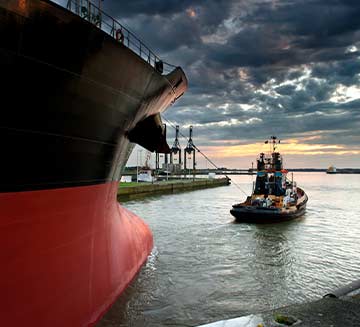Case Study
Ship Maneuvering Evaluation Case Study
S-E-A was contracted by maritime attorneys to evaluate and offer an expert opinion about the activities of a commercial cargo ship transiting the upper reaches of the Houston Ship Channel. The ship was under the direction of a Harbor Pilot with tugboat assistance when an allision (collision with a fixed object) occurred with a concrete pier causing extensive damages to the ship and the pier.
There was no reported failure of the ship's systems and the assisting tugboats were being accused of causing this incident.
S-E-A was provided with a wealth of information that could be used to evaluate the ship's actions. This included: electronic bridge logbook information, voice and data recordings from the ship's bridge, the engine maneuvering electronic data log, GPS track information for the ship, port vessel traffic service “real-time” tracking data, eyewitness reports and incident reports from the ship and tugboats.
Using the information available, S-E-A was able to accurately plot the ship’s track using three-dimensional marine navigation software. This 3-D plot then allowed a comprehensive evaluation of the ship’s rate of advance, and more importantly, its position within the narrow confines of the ship channel as it approached the intended berth.
From the 3-D plot, S-E-A produced a graphical representation of the entire approach of not only the ship but also the assisting tugboats.
How do you know which of a hundred decisions required to get a 21,000-ton ship through a narrow channel was the wrong one?
Assigned Task:
Evaluation of test evidence resulted in the following findings:
- The ship had proceeded on a “normal” track and transit up the ship channel from the sea
- The bridge of the ship was properly manned by competent officers and crew
- The ship’s officers followed the pilot’s recommended instructions carefully and correctly
- There was no report of any machinery failure or other adverse circumstances onboard
- The Houston pilot was provided detailed information about the ship's maneuvering characteristics
- The assisting tugboats received instructions (and followed instructions) only from the Houston pilot
- There was evidence of the pilot’s “inattention” to his task immediately prior to the incident
- An accurate reconstruction of the ship's track allowed S-E-A to determine the time and location at which the ship's position and speed became “in extremis,” such that no action by the ship or the assisting tugboats could have avoided the allision with the concrete pier
- The tugboats were found to have followed the pilot's instructions precisely
- The sole reason for the allision was due to the pilot’s error
S-E-A’s ability to accurately evaluate and recreate accidents relies to some degree on expertise using and combining a broad range of advanced technologies. More importantly, S-E-A’s depth of real-world maritime experience allows for the kind of insight and perspective needed to interpret the mass of data that these technologies can generate.
S-E-A’s multi-disciplinary teams are a large part of why we have been able to help so many clients find real answers. The scientific methodologies cross all disciplines and our wealth of experience in solving a wide range of problems is invaluable in assuring broad perspective and thinking unfettered by familiarity and repetition.


